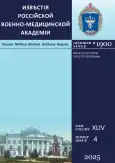Comparative effectiveness of medical care for patients with in-hospital ischemic stroke in primary stroke units and regional comprehensive stroke centers
- 作者: Kolomentsev S.V.1, Voznyuk I.A.2,3, Savello A.V.1,2, Yakovlev A.I.4, Rubleva O.V.5, Tsurikova N.A.6
-
隶属关系:
- Military Medical Academy
- Pavlov First Saint Petersburg State Medical University
- Immanuel Kant Baltic Federal University
- I.I. Dzhanelidze Research Institute of Emergency Medicine
- Mariinskaya City Multi-Field Hospital
- LLC “PLUS”
- 期: 卷 44, 编号 4 (2025)
- 页面: 405-414
- 栏目: Conference Proceedings
- URL: https://journals.eco-vector.com/RMMArep/article/view/691578
- DOI: https://doi.org/10.17816/rmmar691578
- EDN: https://elibrary.ru/SXZZTI
- ID: 691578
如何引用文章
详细
BACKGROUND: In-hospital ischemic stroke is a severe competing condition associated with a high rate of adverse outcomes.
AIM: This work aimed to compare the effectiveness of medical care for patients with in-hospital ischemic stroke in facilities with a primary stroke unit versus a regional comprehensive stroke center.
METHODS: A retrospective analysis was performed, evaluating quality of care and outcomes in 389 patients with in-hospital ischemic stroke across 12 healthcare facilities in Saint Petersburg during 2015–2024: eight hospitals with a regional comprehensive stroke center and one federal medical organization providing 24/7 endovascular care for in-hospital ischemic stroke (n = 268); and three multidisciplinary hospitals with a primary stroke unit (n = 121).
RESULTS: In-hospital ischemic stroke occurred more frequently in internal medicine patients in primary stroke units (66.9% vs 33.1%), whereas in regional comprehensive stroke centers it was more common in surgical patients (56.7% vs 43.3%; p < 0.001). Patients with in-hospital ischemic stroke treated in primary stroke units were older (77.0 ± 13.0 vs 69.0 ± 12.0 years; p < 0.001), had higher comorbidity burden by Charlson Comorbidity Index (8.9 ± 3.7 vs 7.1 ± 2.8; p < 0.001), and were more often admitted urgently (85% vs 57%; p < 0.001). In-hospital ischemic stroke in primary stroke units was associated with more severe neurological deficits (13 ± 7 vs 12 ± 8; p = 0.025), poorer functional outcomes (p < 0.001), and higher in-hospital mortality (53% vs 29%; p < 0.001) compared with regional comprehensive stroke centers. At diagnosis of in-hospital ischemic stroke, angiographic (11% vs 57%; p < 0.001) and perfusion (0.8% vs 5.4%; p < 0.001) neuroimaging studies were performed less frequently in hospitals with primary stroke units than in regional comprehensive vascular centers; emergency reperfusion methods were also used less often (0.8% vs 16.4%; p < 0.001).
CONCLUSION: Differences in functional capacity between primary stroke units and regional comprehensive stroke centers with regard to reperfusion treatment approaches should not adversely influence the timeliness and completeness of diagnostic work-up in patients with in-hospital ischemic stroke. Angiographic and perfusion neuroimaging allows for the use of systemic thrombolytic therapy under expanded indications in primary stroke units, and also enables determination of indications for endovascular interventions to facilitate transfer to the nearest regional comprehensive stroke center in accordance with routing protocols.
全文:
作者简介
Sergey Kolomentsev
Military Medical Academy
编辑信件的主要联系方式.
Email: vmeda-nio@mil.ru
ORCID iD: 0000-0002-3756-6214
SPIN 代码: 6439-6701
MD, Cand. Sci. (Medicine)
俄罗斯联邦, Saint PetersburgIgor Voznyuk
Pavlov First Saint Petersburg State Medical University; Immanuel Kant Baltic Federal University
Email: voznjouk@yandex.ru
ORCID iD: 0000-0001-7192-0961
SPIN 代码: 3340-2897
MD, Dr. Sci. (Medicine), Professor
俄罗斯联邦, Saint Petersburg; KaliningradAleksandr Savello
Military Medical Academy; Pavlov First Saint Petersburg State Medical University
Email: vmeda-nio@mil.ru
ORCID iD: 0000-0002-1680-6119
SPIN 代码: 3185-9332
MD, Dr. Sci. (Medicine), Professor
俄罗斯联邦, Saint Petersburg; Saint PetersburgAleksandr Yakovlev
I.I. Dzhanelidze Research Institute of Emergency Medicine
Email: yakovlevai92@yandex.ru
ORCID iD: 0000-0001-7648-4388
SPIN 代码: 3700-7008
MD, Cand. Sci. (Medicine)
俄罗斯联邦, Saint PetersburgOlga Rubleva
Mariinskaya City Multi-Field Hospital
Email: nevrolog@mail.ru
ORCID iD: 0009-0002-2271-4672
SPIN 代码: 1490-4885
俄罗斯联邦, Saint Petersburg
Nadezhda Tsurikova
LLC “PLUS”
Email: tsurikova.na@ya.ru
ORCID iD: 0000-0002-3946-430X
SPIN 代码: 9636-5470
MD, Cand. Sci. (Medicine)
俄罗斯联邦, Rostov-on-Don参考
- Charlson ME, Pompei P, Ales KL, MacKenzie CR. A new method of classifying prognostic comorbidity in longitudinal studies: development and validation. J Chronic Dis. 1987;40(5):373–383. doi: 10.1016/0021-9681(87)90171-8
- Adams HP Jr, Davis PH, Leira EC, et al. Baseline NIH Stroke Scale score strongly predicts outcome after stroke: A report of the Trial of Org 10172 in Acute Stroke Treatment (TOAST). Neurology. 1999;13;53(1):126–231. doi: 10.1212/wnl.53.1.126
- Suponeva NA, Yusupova DG, Zhirova ES, et al. Validation of the modified Rankin Scale in Russia. Nevrologiya, neiropsikhiatriya, psikhosomatika = Neurology, Neuropsychiatry, Psychosomatics. 2018;10(4):36–39. doi: 10.14412/2074-2711-2018-4-36-39 EDN: SLWIKP
- Jauch E, Saver J, Adams H, et al. Guidelines for the Early Management of Patients With Acute Ischemic Stroke: A Guideline for Healthcare Professionals From the American Heart Association/American Stroke Association. Stroke. 2013;44(3):870–947. doi: 10.1161/str.0b013e318284056a
- Matsui H, Koike S, Fushimi K, et al. Effect of neurologic specialist staffing on 30-day-in-hospital mortality after cerebral infarction. Annals of Clinical Epidemiology. 2019;1(3):86–94. doi: 10.37737/ace.1.3_86
- Nishimura K, Ogasawara K, Kitazono T, et al. Impact of Physician Volume and Specialty on In-Hospital Mortality of Ischemic and Hemorrhagic Stroke. Circulation Journal. 2021;85:1876–1884. doi: 10.1253/circj.CJ-20-1214
- Neplyueva GA, Soloveva AE, Krivopolenova SD, et al. The relationship between the specialized hospitals and departments medical doctors provision with myocardial infraction and cerebral stroke lethality. Russian Journal of Preventive Medicine. 2024;27(7):30–37. doi: 10.17116/profmed20242707130 EDN: LJVDDO
补充文件






